当前位置:网站首页>unusual understanding
unusual understanding
2022-08-10 22:01:00 【GracefulBlack】
CThe language tradition handles errors
- 返回错误码 , 缺陷:An error number is returned,Don't know which error is,很难受,Also need to check the error code table
- 终止程序,比如assert,缺陷:有点太激进了,It crashes immediately after encountering an error

C++异常
概念

用法
- catchThe code is not executed sequentially,没有异常的情况,catchThe code is skipped directly
- 代码出现异常时,Code is not executed sequentially,will jump right to where it was caught

#include<iostream>
#include<string>
#include<time.h>
#include <thread>
#include <vector>
using namespace std;
double Division(int a, int b)
{
// 当b == 0时抛出异常
if (b == 0)
throw "Division by zero condition!";
else
return ((double)a / (double)b);
}
void Func1()
{
try
{
int len, time;
cin >> len >> time;
cout << Division(len, time) << endl;
}
catch (int errid)
{
cout << errid << endl;
}
}
void Func2()
{
int len, time;
cin >> len >> time;
if (time != 0)
{
throw 1;
}
else
{
cout << len << " " << time << endl;
}
}
int main()
{
try
{
Func1();
Func2();
}
catch (const char* errmsg)
{
cout << errmsg << endl;
}
catch (int errid)
{
cout << errid << endl;
}
catch (...)
{
cout << "unkown exception" << endl;
}
return 0;
}
- If an exception object is thrown,What is thrown is a copy of the exception object,Because this object may be generated temporarily,The copied temporary object will be therecatch以后销毁
double Division(int a, int b)
{
// 当b == 0时抛出异常
if (b == 0)
{
string str("除零错误");
throw str;
}
else
{
return ((double)a / (double)b);
}
}
void Func1()
{
int len, time;
cin >> len >> time;
cout << Division(len, time) << endl;
}
int main()
{
try
{
Func1();
}
catch (const string& errmsg)
{
cout << errmsg << endl;
}
return 0;
}
- If the thrown exception is not caught,那么程序就会被终止
- catch(…)means to capture any type
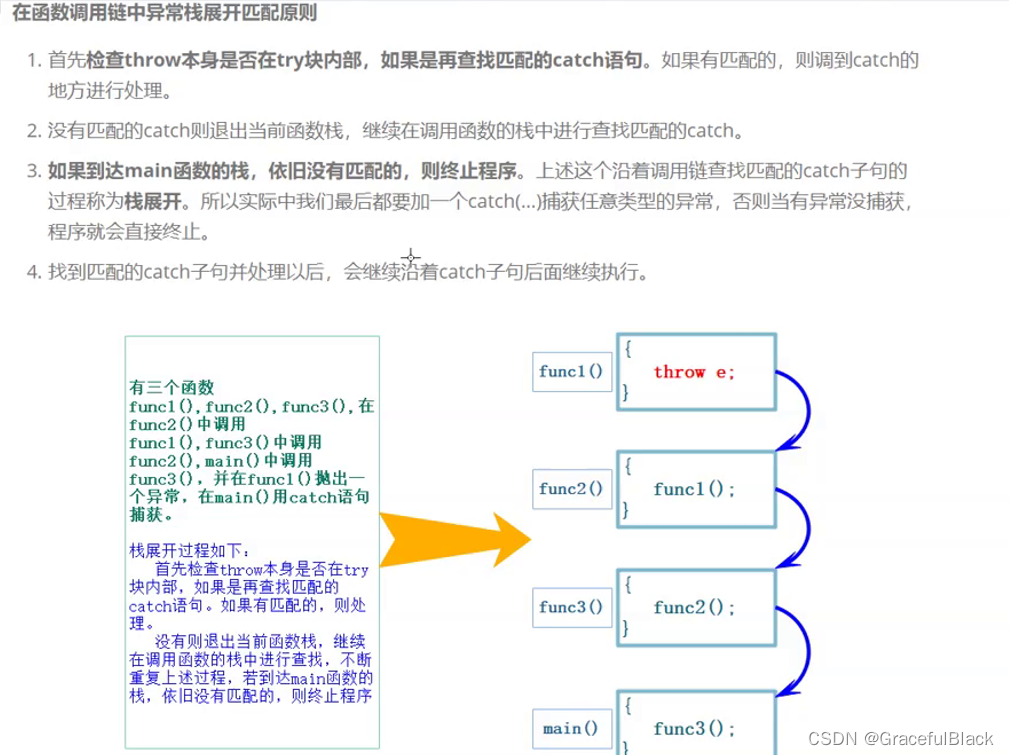
- Below after being capturedfunc2会继续执行 , catchSubsequent clauses will continue to execute
double Division(int a, int b)
{
// 当b == 0时抛出异常
if (b == 0)
{
string str("除零错误");
throw str;
}
else
{
return ((double)a / (double)b);
}
}
void Func2()
{
int len, time;
cin >> len >> time;
if (time != 0)
{
throw 3.33;
}
else
{
cout << len << " " << time << endl;
}
}
void Func1()
{
try
{
int len, time;
cin >> len >> time;
cout << Division(len, time) << endl;
}
catch (const string& errmsg)
{
cout << errmsg << endl;
}
Func2();
}
int main()
{
try
{
Func1();
}
catch (const string& errmsg)
{
cout << errmsg << endl;
}
catch (int errid)
{
cout << errid << endl;
}
catch (...)
{
cout << "未知异常" << endl;
}
return 0;
}
代码二
double Division(int a, int b)
{
// 当b == 0时抛出异常
if (b == 0)
{
throw "Division by zero condition!";
}
return (double)a / (double)b;
}
void Func()
{
// 这里可以看到如果发生除0错误抛出异常,另外下面的array没有得到释放.
// 所以这里捕获异常后并不处理异常,异常还是交给外面处理,这里捕获了再
// 重新抛出去.
int* array = new int[10];
int len, time;
cin >> len >> time;
try
{
cout << Division(len, time) << endl;
}
catch (...) // 拦截异常,不是要处理异常,Instead, release resources normally
{
cout << "delete []" << array << endl;
delete[] array;
throw; // Rethrow whatever object is caught
}
cout << "delete []" << array << endl;
delete[] array;
}
int main()
{
try
{
Func();
}
catch (const char* errmsg)
{
cout << errmsg << endl;
// 记录日志
}
return 0;
}
自定义异常体系
- 服务器开发中通常使用的异常继承体系
// 服务器开发中通常使用的异常继承体系
class Exception
{
public:
Exception(const string& errmsg, int id)
:_errmsg(errmsg)
, _id(id)
{
}
virtual string what() const
{
return _errmsg;
}
protected:
string _errmsg;
int _id;
};
class SqlException : public Exception
{
public:
SqlException(const string& errmsg, int id, const string& sql)
:Exception(errmsg, id)
, _sql(sql)
{
}
virtual string what() const
{
string str = "SqlException:";
str += _errmsg;
str += "->";
str += _sql;
return str;
}
private:
const string _sql;
};
class CacheException : public Exception
{
public:
CacheException(const string& errmsg, int id)
:Exception(errmsg, id)
{
}
virtual string what() const
{
string str = "CacheException:";
str += _errmsg;
return str;
}
};
class HttpServerException : public Exception
{
public:
HttpServerException(const string& errmsg, int id, const string& type)
:Exception(errmsg, id)
, _type(type)
{
}
virtual string what() const
{
string str = "HttpServerException:";
str += _type;
str += ":";
str += _errmsg;
return str;
}
private:
const string _type;
};
void SQLMgr()
{
srand(time(0));
if (rand() % 7 == 0)
{
throw SqlException("权限不足", 100, "select * from name = '张三'");
}
//throw "xxxxxx";
}
void CacheMgr()
{
srand(time(0));
if (rand() % 5 == 0)
{
throw CacheException("权限不足", 100);
}
else if (rand() % 6 == 0)
{
throw CacheException("数据不存在", 101);
}
SQLMgr();
}
void HttpServer()
{
// ...
srand(time(0));
if (rand() % 3 == 0)
{
throw HttpServerException("请求资源不存在", 100, "get");
}
else if (rand() % 4 == 0)
{
throw HttpServerException("权限不足", 101, "post");
}
CacheMgr();
}
void ServerStart()
{
while (1)
{
this_thread::sleep_for(chrono::seconds(1));
try {
HttpServer();
}
catch (const Exception& e) // 这里捕获父类对象就可以
{
// 多态
cout << e.what() << endl;
}
catch (...)
{
cout << "Unkown Exception" << endl;
}
}
}
int main()
{
ServerStart();
return 0;
}
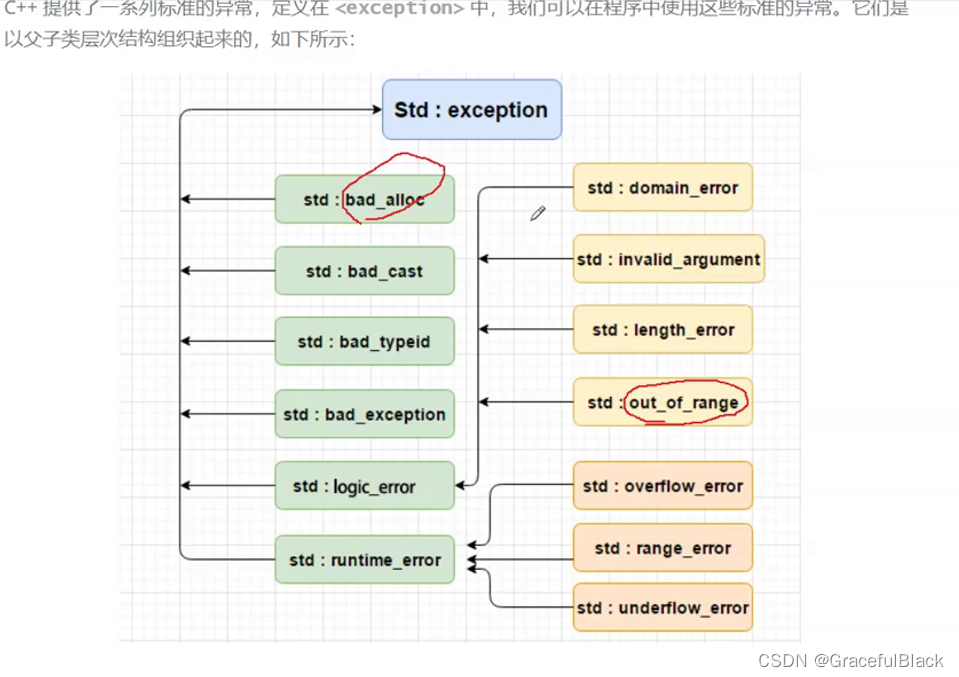
异常安全
- Better not to throw in the constructor ->Objects may be incomplete or not fully initialized
- Better not to throw in the destructor ->可能导致资源泄漏(内存泄漏,句柄未关闭等)

异常规范
- thow ()If there is an exception type in it,Then that's where the function might throwi有类型
- 函数后面跟throw() ,The brackets are empty,表示函数不抛异常,但在C++11中更喜欢用noexcept
- No interface description,Then the description can throw any exception
- However, it may not be standard in practice,It is difficult to implement in practice,It is also possible that someone wrote it but secretly throws an exception
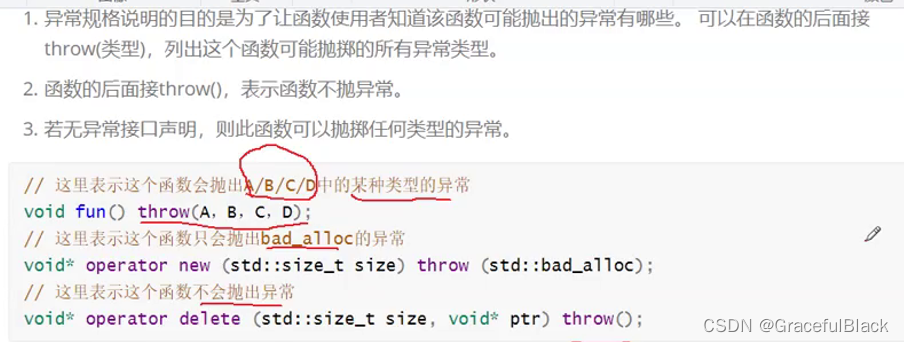
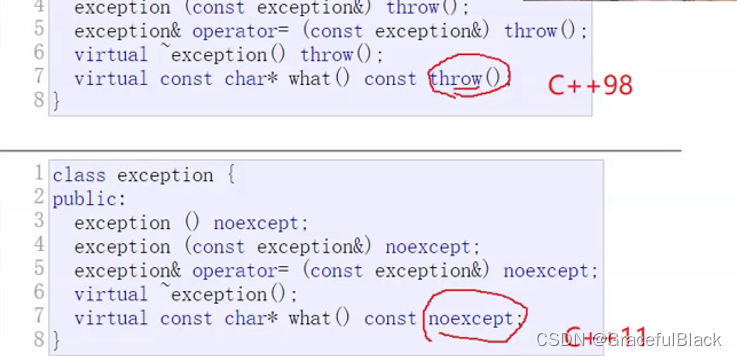
异常的优缺点(考点)
优点:
- Accurately display the wrong kinds of information,better positioningbug
- The call chain is deep,It's hard for the outermost layer to get errors
- Third-party libraries need to use exceptions
- Some classic functions cannot use error codes(For example, it will return a value itself)
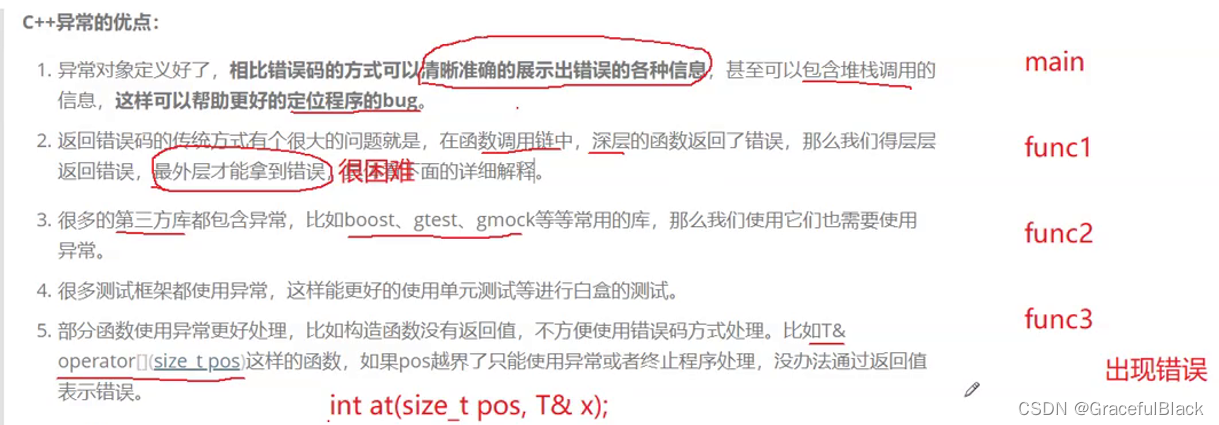
缺点: - Perform flow hopping,Like the previous recommendation to use sparinglygoto(重要)
- 有一定的性能开销,但可以忽略不计(Previously returned an error code,Now returns an object,There is also stack overhead)(不是很重要)
- 没有垃圾回收机制,learning costs ->RAII->Only smart pointers,lock_guard (很重要)
- C++The exception system is not well defined(不是很重要)

总的来说,利大于弊 ,OO
边栏推荐
猜你喜欢
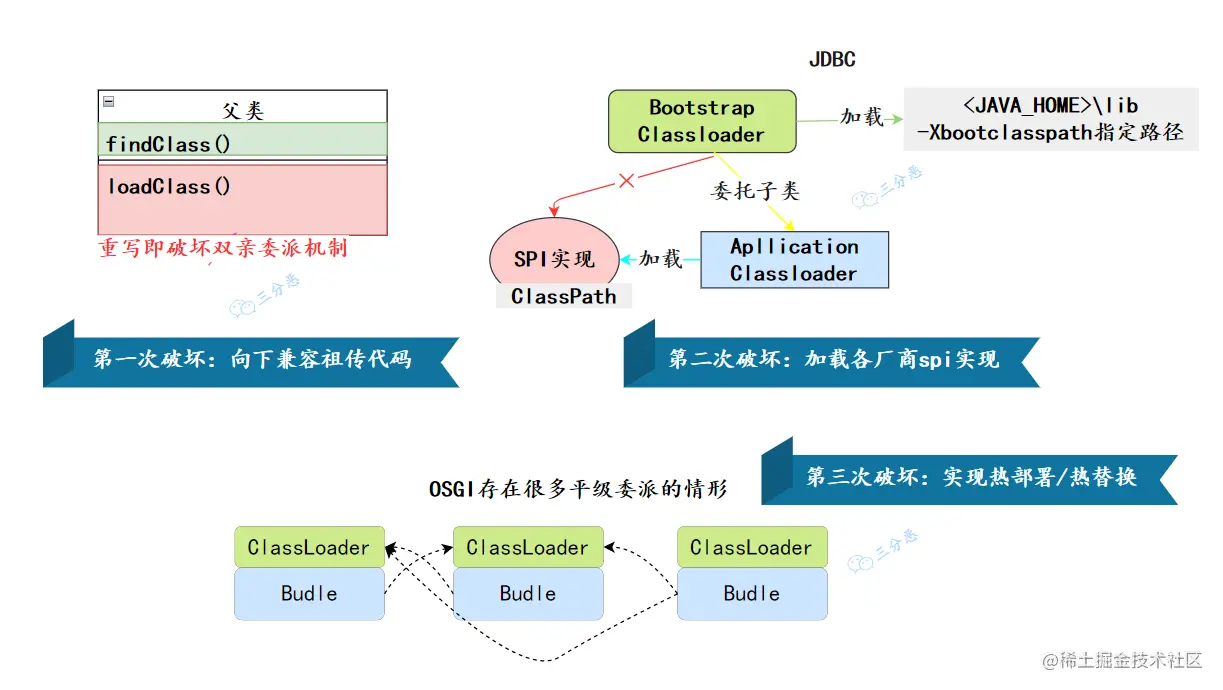
JVM classic fifty questions, now the interview is stable

Shell编程之条件语句(二)
![[SQL brush questions] Day3----Special exercises for common functions that SQL must know](/img/b8/05589138441ada5d453297de7d181b.png)
[SQL brush questions] Day3----Special exercises for common functions that SQL must know
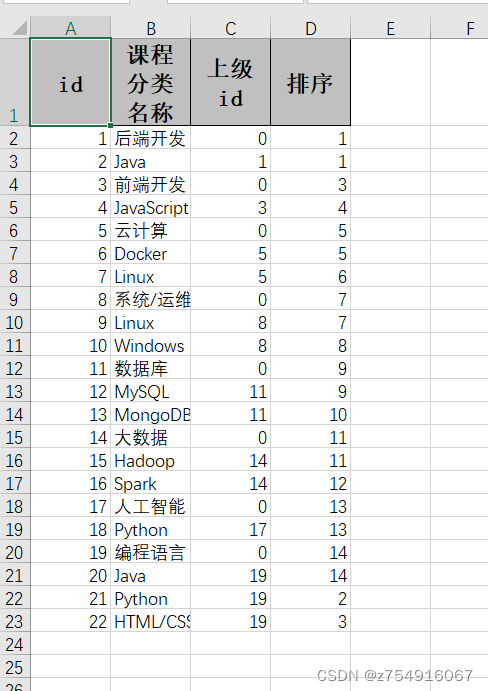
Live Classroom System 08 Supplement - Tencent Cloud Object Storage and Course Classification Management
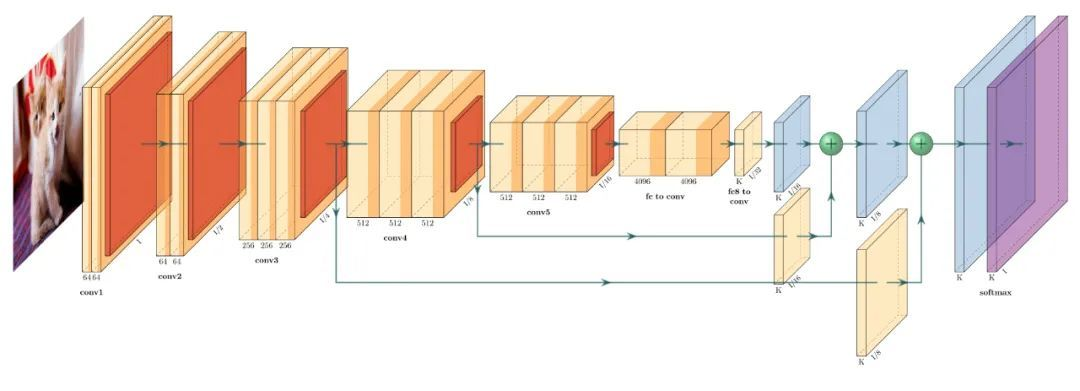
Mark!画出漂亮的神经网络图!神经网络可视化工具集锦搜集

paddle 35 paddledetection保存训练过程中的log信息

JVM经典五十问,这下面试稳了

数字化转型:如何引导创新领导者

石油化工行业商业供应链管理系统:标准化供应商管理,优化企业供应链采购流程

【PCBA solution】Electronic grip strength tester solution she'ji
随机推荐
LeetCode-36-二叉搜索树与双向链表
Mark!画出漂亮的神经网络图!神经网络可视化工具集锦搜集
2022.8.8 Selected Lectures on Good Topics (Number Theory Field)
shell (text printing tool awk)
JS中的filter、map、reduce
shell编程之正则表达式与文本处理器
《mysql 从入门到内卷再到入土》——Mysql基础 学习笔记目录
Web Reverse Lilac Garden
2022.8.9 模拟赛
基于Pix4Dmapper的运动结构恢复法无人机影像三维模型重建
wget编译升级故障解决
DDL:视图——《mysql 从入门到内卷再到入土》
C. Rotation Matching
xshell (sed command)
About DataFrame: Processing Time
深度学习之 12 循环神经网络RNN2
这些不可不知的JVM知识,我都用思维导图整理好了
B. Codeforces Subsequences
快消品行业经销商协同系统:实现经销商可视化管理,提高沟通执行效率
自组织是管理者和成员的双向奔赴